Sony Bravia KDL-46Z4500 46in LCD TV Review
Sony Bravia KDL-46Z4500 46in LCD TV
This Sony Bravia LCD TV features 200Hz processing but what's it like overall?
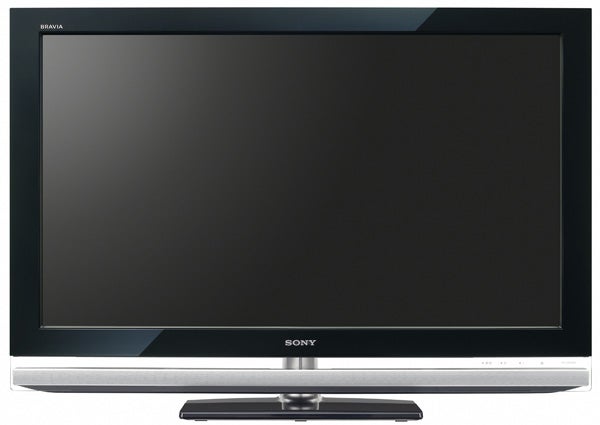
Verdict
Key Specifications
- Review Price: £1653.35
In an AV industry where ‘my numbers are bigger than yours’ is the mantra of the day, Sony definitely scored a coup at this year’s IFA show in Berlin by showing off a TV series, the Z4500s, with 200Hz processing.
In fact, so strong an impact did the 200Hz claim have, that it made me reflect on how remarkable it is why nobody has done it before. The more traditional 100Hz system for doubling the 50Hz PAL frame rate has, after all, been around since CRT TVs walked the Earth.
As its name suggests, the 200Hz system found on the KDL-46Z4500 we have before us today ups the frame rate of what you’re watching by calculating three additional frames of image data for every original frame. The result, claims Sony, should be ‘the smoothest and clearest motion reproduction to be achieved by an LCD TV’. 
Somehow we have a feeling that Philips at the very least might like to take issue with that statement, but we’ll let it ride for now. Not least because the 46Z4500 might actually live up to that promise!
It’s important to stress before we go any further that the 46Z4500’s Motionflow 200Hz system doesn’t just repeat the same image three times. Instead it calculates ‘missing’ image data between neighbouring frames of the original source, predicting movement in all directions, so that motion can be portrayed with less blurring and judder.
As if this wasn’t enough, the 46Z4500 also employs a further new image enhancement technology called Image Blur Reduction, which boosts the sharpness of the final picture by improving the original image frames BEFORE they’re processed by Motionflow 200Hz.
Inevitably, given that this is a Bravia TV, the 46Z4500 rounds out its innovative picture processing suite with Bravia Engine 2: Sony’s latest proprietary image processing engine. This gets involved with everything from colour reproduction to contrast, sharpness, noise reduction, scaling and fine detail, and has worked some pretty fine magic on other recent Sony screens. So we have high hopes for it here too, provided it doesn’t somehow run into conflict with the 200Hz system.
As you’d expect of pretty much any large LCD TV now, the 46Z4500 sports a Full HD pixel count. But it’s anything but standard on the contrast front, thanks to a claimed dynamic contrast ratio of 80,000:1, which is a good few notches higher than that of most LCD TVs. Not counting the recent ones from Philips and Samsung that use LED backlighting, of course.
The 46Z4500’s connections are a slightly mixed bag. On the downside you only get three HDMIs when we’re really coming to expect premium TVs like the 46Z4500 to supply four. But on the upside the TV ships with a USB port, a Digital Media Port for playing stuff (via adaptors) from various portable media devices, and a DLNA-certified Ethernet port onboard so that the TV can seamlessly network with other DLNA-certified devices. This enables the 46Z4500 to play music and picture files stored on PCs or other external devices such as Sony’s Giga Juke music server.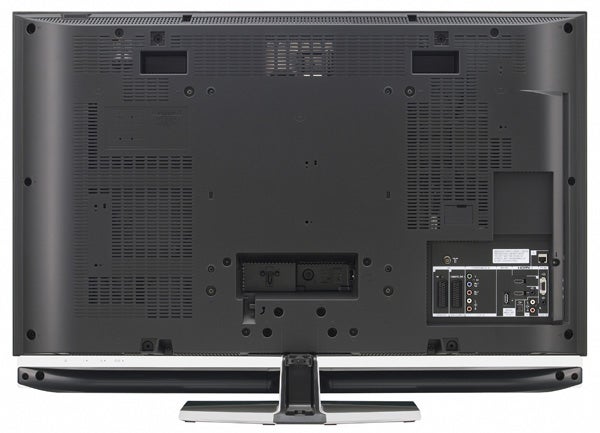
Sony’s neat double-axis on-screen menus system contains a number of features that we’d strongly recommend you play around with if you want to get the best from the 46Z4500. Highlights include a backlight adjustment, standard and MPEG noise reduction routines, a Contrast Enhancer, plus a colour space adjustment that can expand the colours from a source to meet the colour capacity of the TV’s LCD panel.
One little negative side note to all this talk of features is that I really didn’t like the remote control used to access them. The problem is the ‘circle within a circle’ arrangement at the remote’s heart, which finds a number of key buttons appearing in a tight circle around the left, right, up, and down movement arrows used for menu navigation. I lost count, for instance, of how many times I accidentally pressed the ‘Home’ button, thus making the on-screen menus disappear, when I meant to press the ‘down’ navigation button.
The home for all the 46Z4500’s fine-sounding technology is a very attractive one, thanks to a combination of the beautifully illuminated Sony logo set within a stunningly finished Midnight Sky bezel (dusted with sparkling powder, no less!), all wrapped up by Sony’s trademark transparent strip along the TV’s bottom edge.
Before I get down to the key business of finding out what if anything 200Hz brings to the 46Z4500’s picture party, I really feel the need to start the testing part of this review by saying that, thankfully, the 46Z4500 does not suffer with the really distracting backlight pooling problems I witnessed with recent Sony W4500 models. There’s a tiny bit of light spillage to the top left, but this is hardly ever noticeable under normal viewing conditions. Phew.
And so to 200Hz., and the discovery that it’s good, but not the absolute picture quality tour de force we might have been praying for. In other words, while it does make motion in pictures look smoother and – usually – clearer than you’d get from even a 100Hz LCD TV, the leap forward isn’t anything like as profound as the leap from 50Hz to 100Hz.
That sounded a little harsher than I intended it to. Obviously any improvement in picture quality, no matter how minor, deserves credit. I just think it’s important to cut away a little of the hype surrounding the 200Hz feature; to say that the difference it makes is marginal rather than revolutionary.
In fact, I’d argue that Philips’ HD Natural Motion system, which has been around for the best part of a year now, actually makes motion look even smoother and clearer than Sony’s 200Hz engine.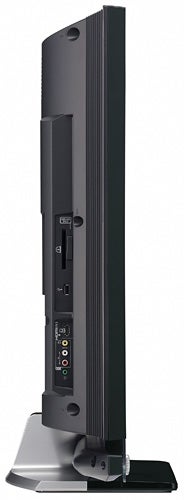
Having said that, Sony’s new motion processing does score points of its own over the Philips engine for the way it generates practically no nasty side effects whatsoever. With the Philips HD Natural Motion TVs you’re forever tweaking various settings with different types of source material, in order to ensure you’re not left looking at too many nasty image processing artifacts. But with the 46Z4500 you can enjoy the 200Hz benefits glitch-free with pretty much anything, so long as you don’t often set the Motionflow system higher than its Standard level.
Just occasionally something particularly tricky, such as a facial close-up moving across the screen, can seem to smear a little bit, either because of problems with the speed of the Sony’s processing or because the processing can’t quite figure out the best thing to put in the three extra frames it’s calculating. But these instances are rare, and easy to live with in the context of all the good the 200Hz engine is doing.
And anyway, the 200Hz system is far from the end of the 46Z4500’s talents. Its colours, for instance, are superb, portraying with exceptional vibrancy the riot of colour on show during the Captain Jack hanging sequence towards the end of the first ”Pirates of the Caribbean” film.
Using the Wide colour mode actually makes these shots look almost scarily aggressive and eye-catching. But it seemed to me that the tonal accuracy suffered a little in this mode, so I personally preferred the Standard setting.
The 46Z4500’s black levels are very good by normal LCD standards too. The shots of the Black Pearl when Elizabeth first discovers she’s on a ghost ship suffer only very little with the customary LCD greyness, especially if you have the contrast booster set to medium and the backlight set right down to three or at most four. There’s also enough shadow detail visible in dark scenes to avoid the ‘empty hole’ phenomenon that can afflict dark picture segments in lesser screens.
If you’re wondering why I went to the trouble of saying ‘normal LCD standards’ back there, it’s because we’re starting to see a new breed of LCD TVs emerging that use LED array lighting rather than standard single fluorescent lamps. And these have already proved able to deliver black levels far beyond that possible even from Sony’s 46Z4500. 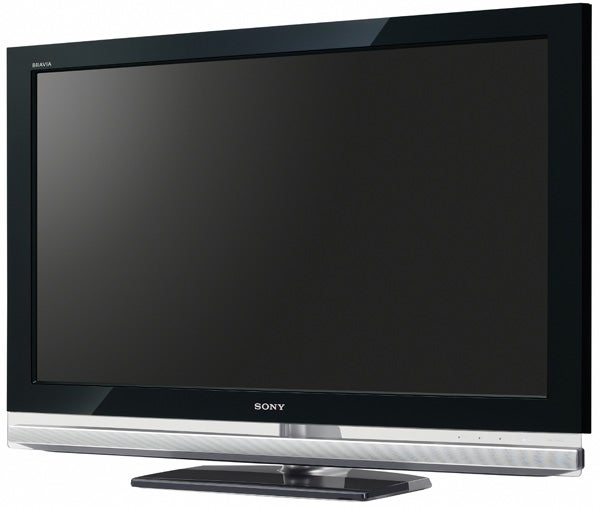
However, given that we’ve found Sony’s screen going for nearly £500 less than, say, the LED-sporting, 42in Philips 42PFL9803H, drawing too many comparisons between these two sets doesn’t really seem entirely fair. So I’ll cease and desist with immediate effect.
Some Sony TVs in the past have struggled a bit with standard definition sources. So I have to say I was worried that all the extra processing introduced with the 46Z4500 might really cause things to fall apart. But actually, while there’s a slight tendency to exaggerate any MPEG processing noise that might be in a source, especially if you don’t keep the contrast and brightness settings reined in, the 46Z4500 actually does a pretty capable job of upscaling standard definition sources to its Full HD pixel count.
Rather more unusual is the way the 46Z4500 can even emphasise MPEG noise in Blu-ray discs, especially in dark areas. Thankfully this problem can be considerably improved if you use the brightness-reducing Cinema mode, but please bear in mind that this mode actually reduces the brightness so much that it could be an issue if you’ve got a particularly bright room.
Now I’ve started down a negative path, I might as well add that occasionally I spotted the auto contrast feature reacting to a brightness change in the source a little slower than I’d have ideally liked. Also, with Motionflow set to high, fast moving objects can tend to appear with a slight trail behind them. And similar smearing was also sometimes visible with HD sources during particularly tricky, motion and detail-heavy footage, such as the scenes in the hallucinogenic fog towards the end of ”Batman Begins”.
Dragging my thoughts away from the mostly impressive but certainly not perfect picture situation to focus on the 46Z4500’s audio, I have to say I was a wee bit underwhelmed. There’s good definition in the soundstage, and it spreads far and wide around your room without losing cohesion. But it also lacks the raw power and dynamic range to really open up to meet the challenge of a raucous action film sequence – especially if you’re using anything other than the Dynamic audio preset.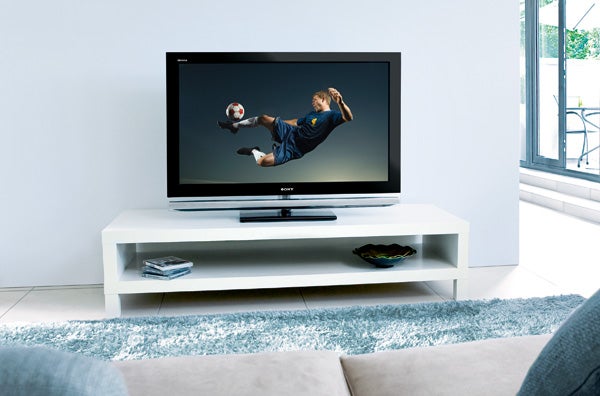
”’Verdict”’
I don’t mind saying that I really agonised over this one. Should it end up with a 9 or an 8? In the end, the quality of the 200Hz engine together with the other undeniable strengths of the picture just did enough to bring me down on the side of an overall 9/10.
My biggest concern with the 46Z4500 is ultimately its price. Sony lists the set at a phenomenal £2,340 on its own website, and even the online price of £1,654 we’ve found still looks a touch steep given that the 200Hz benefits are only pretty marginal.
In the end, it was weirdly the quality control problems with Sony’s W4500 models that persuaded me to look past my value concerns and grant the TV TrustedReviews Recommended status. For the fact is that if you fancy getting hold of the undoubted quality of Sony’s current core LCD picture technology but don’t want to bother with the lottery otherwise known as buying a W4500 (apparently a few W4500’s exist that don’t have backlight problems, if you’re lucky enough to find one!), the Z4500 range appears to be the only place to go.
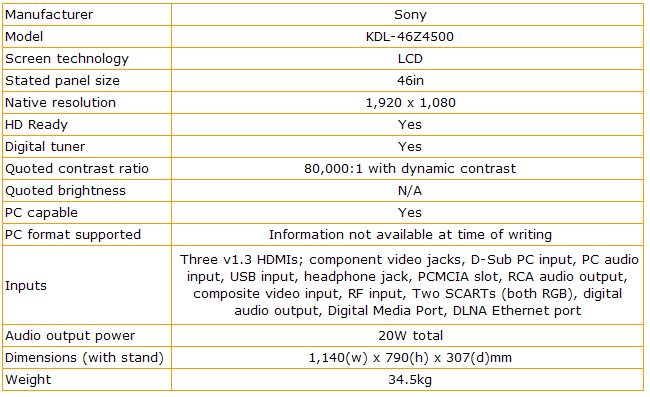
How we test televisions
We test every TV we review thoroughly over an extended period of time. We use industry standard tests to compare features properly. We’ll always tell you what we find. We never, ever, accept money to review a product.
Trusted Score
Score in detail
-
Features 10
-
Value 7
-
Image Quality 9
-
Design 9
-
Sound Quality 8

